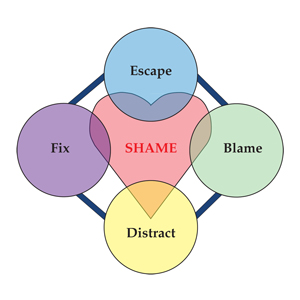The SIIC Model Explained
 Stress-Induced Impaired Coping™ is the term Dr. Perlmutter has coined to describe the condition affecting virtually all family systems impacted by addiction, compulsion, or severe mental illness. The concept provides a template for thinking about and understanding wounded family systems including how members manage and relate. SIIC theory identifies the six most common disabling characteristics of the family environment: disorder, danger, disconnection, deprivation, doubt, and denial. Caught in such an environment, family members unconsciously adopt a set of beliefs and ways of behaving that help them cope but also keeps things stuck. These patterns are transmitted across the generations through modeling and observing.
Stress-Induced Impaired Coping™ is the term Dr. Perlmutter has coined to describe the condition affecting virtually all family systems impacted by addiction, compulsion, or severe mental illness. The concept provides a template for thinking about and understanding wounded family systems including how members manage and relate. SIIC theory identifies the six most common disabling characteristics of the family environment: disorder, danger, disconnection, deprivation, doubt, and denial. Caught in such an environment, family members unconsciously adopt a set of beliefs and ways of behaving that help them cope but also keeps things stuck. These patterns are transmitted across the generations through modeling and observing.
Research is clearly demonstrating that there is a genetic transmission of these beliefs and associated ways of coping that lies far outside our consciousness. This makes it possible for a family member with little or no personal history of trauma to react to the family system environment in a way that’s genetically influenced and appears to “make no sense to us,” as one mother said.
The model assumes that all family members are attempting to make tolerable life in the wounded environment either by escaping, fixing, blaming, or distracting. These are the four most common behaviorally defined roles found. Each has its own set of emotional effects and underlying beliefs. Taken together, members playing their roles, create a seemingly stable system which many call “dysfunctional.”
Ironically, these systems function very well to
- Cover up secrets (shame and traumas) that seem too terrible to face
- Permit members to overlook the pain and uncertainty of life in the system
- Hold members in rigid roles and ways of responding that maintain the status quo
- Preserve a way of thinking about ourselves that sounds OK
Perpetuate the cycles of loss, illness, relapse, denial and shame
The SIIC model also provides language for the powerful narratives (stories) family members tell themselves that hold them in these roles. In addition, the model describes the environmental characteristics of the wounded family system and considers the trans-generational history of loss and shame commonly associated with this condition.
There Is A Solution
The companion family systems SIIC recovery model offers relief for individual family members and promotes healing and balance for the system itself. Patterns of loss, relapse, brief relief, and despairing grief which saturate the family atmosphere are interrupted along with the transmission to the next generation of impaired coping and its associated disorder. Members are guided to adopt a series of steps toward SIIC recovery that begin with examining the current family “deal.” Once a member declares that deal no longer okay, the work revolves around creating a plan based on the personal declaration: “It Stops With Me.” Following an organic process driven by the personal values, morals, resources, and capacities of each family, a plan to change how members participate in the deal is developed. Shifts are immediately experienced toward serenity, more open communication and an improved quality of life. Members are shown how to return focus to their own spiritual, emotional, financial, physical, sexual, and interpersonal needs and away from the hallmark impaired coping behaviors: escaping, fixing, blaming, and distracting. SIIC recovery values freedom, truth, and connection and employs grace and kindness to guide members toward sustainable change.
One mantra family members are encouraged to adopt: “My serenity and my quality of life will no longer be conditional on the behavior or mental health of anyone else, including my children, my parents or my spouse.” Please note: this never involves so-called “tough love,” kicking someone out, or cutting anyone off.

